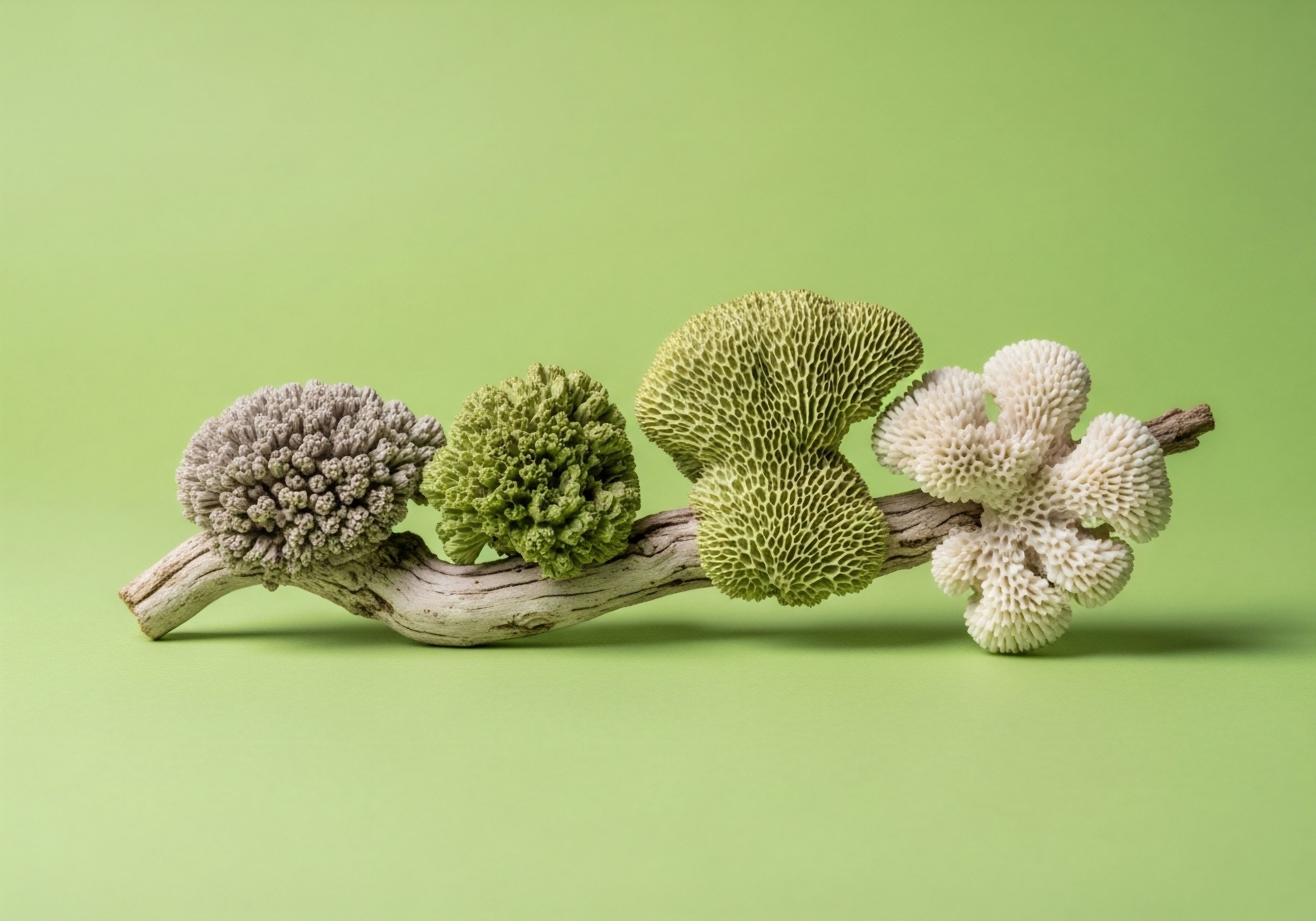

Fundamentals
A sensation of being out of alignment, a persistent feeling that something within your biological framework is not quite right, often accompanies the journey into hormonal recalibration. Many individuals report a subtle yet pervasive shift in their baseline well-being, experiencing symptoms that defy easy explanation.
Perhaps a lingering fatigue settles in, or emotional regulation feels more challenging than before. These subjective experiences are not imagined; they represent genuine signals from your internal systems, indicating a need for careful consideration and precise adjustment. Understanding these initial responses is paramount, as they often represent the body’s adaptive processes at work, rather than a failure of the therapeutic intervention itself.
The endocrine system, a complex network of glands and hormones, operates as the body’s internal messaging service. Hormones, these potent chemical messengers, circulate throughout the bloodstream, influencing nearly every physiological process, from energy metabolism and mood regulation to reproductive function and cognitive clarity.
When this delicate balance is disrupted, whether by age, environmental factors, or underlying health conditions, the consequences can manifest as a wide array of symptoms. Restoring hormonal equilibrium through targeted interventions, such as specific biochemical recalibration protocols, aims to re-establish optimal physiological function.
Initial shifts in well-being during hormonal recalibration are often the body’s adaptive responses, signaling internal adjustments.

The Body’s Initial Adaptation to Hormonal Shifts
When exogenous hormones are introduced into the body, or when endogenous hormone production is modulated, the system does not simply accept these changes passively. Instead, a dynamic process of adaptation begins. This period of adjustment can sometimes lead to transient symptoms that might feel counterintuitive, giving the impression of a temporary decline in well-being.
This phenomenon is a testament to the body’s intricate feedback loops, which strive to maintain a state of internal constancy. The hypothalamic-pituitary-gonadal (HPG) axis, for instance, is a prime example of such a feedback system, where the brain communicates with the gonads to regulate hormone production. Introducing external hormones can temporarily alter the signals within this axis, prompting a period of re-calibration.
Consider the analogy of adjusting a thermostat in a finely tuned climate control system. When the desired temperature is altered, the system does not immediately settle at the new setting. There might be an initial overshoot or undershoot as the heating or cooling mechanisms engage and disengage, gradually bringing the environment to the desired state.
Similarly, the human body, when presented with new hormonal inputs, requires time to adjust its internal regulatory mechanisms. This period of flux can manifest as temporary discomfort or an exacerbation of certain symptoms before the system stabilizes at a more optimal level.

Why Do Some Individuals Experience Initial Discomfort?
The experience of feeling less than optimal at the outset of a hormonal optimization protocol is not universal, yet it is a recognized aspect of the process for some individuals. Several physiological factors contribute to this transient phase. One primary reason relates to the body’s existing receptor sensitivity and the density of these receptors.
Hormones exert their effects by binding to specific receptor sites on cells. If these receptors have been downregulated due to prolonged hormonal deficiency or dysregulation, their responsiveness to newly introduced hormones may initially be suboptimal. The system needs time to upregulate these receptors and restore their sensitivity, allowing for more efficient hormonal signaling.
Another contributing factor involves the metabolic pathways responsible for hormone processing and elimination. The liver, in particular, plays a central role in metabolizing hormones. When hormone levels change, the liver’s enzymatic systems must adapt to the new metabolic load.
This adaptation can sometimes lead to temporary fluctuations in the levels of various hormone metabolites, which might influence how an individual feels. Additionally, the body’s detoxification pathways, which are responsible for clearing metabolic byproducts, may experience an increased demand, potentially leading to mild, transient symptoms like fatigue or headaches.
The individual’s baseline health status, including nutritional deficiencies, chronic stress levels, and gut microbiome health, also significantly influences the initial response. A body already under significant physiological stress may have a reduced capacity to adapt smoothly to hormonal changes. Addressing these foundational elements of wellness concurrently with hormonal interventions can often mitigate the severity and duration of any initial discomfort.
This integrated approach acknowledges that the endocrine system does not operate in isolation; it is deeply interconnected with all other physiological systems.


Intermediate
Navigating the specifics of biochemical recalibration protocols requires a precise understanding of how various agents interact with the body’s systems. When considering interventions like Testosterone Replacement Therapy (TRT) or Growth Hormone Peptide Therapy, the initial phase of treatment can sometimes involve a period where the body adjusts to new hormonal concentrations.
This adjustment period is a critical aspect of the therapeutic journey, often requiring careful monitoring and, at times, minor adjustments to the protocol to ensure optimal progression toward improved well-being.

Testosterone Replacement Therapy for Men
For men experiencing symptoms of low testosterone, such as diminished vitality, reduced muscle mass, or cognitive fogginess, Testosterone Replacement Therapy offers a pathway to restoring physiological balance. A standard protocol often involves weekly intramuscular injections of Testosterone Cypionate (200mg/ml). This form of testosterone provides a steady release, aiming to mimic the body’s natural diurnal rhythm.
To maintain the intricate balance of the endocrine system and mitigate potential side effects, additional medications are frequently integrated into the protocol. Gonadorelin, administered via subcutaneous injections twice weekly, helps preserve natural testosterone production and testicular function by stimulating the pituitary gland to release luteinizing hormone (LH) and follicle-stimulating hormone (FSH). This approach helps prevent testicular atrophy, a common concern with exogenous testosterone administration.
Another key component is Anastrozole, an oral tablet taken twice weekly. This medication functions as an aromatase inhibitor, blocking the conversion of testosterone into estrogen. While estrogen is essential for men’s health, excessive levels can lead to undesirable effects such as gynecomastia or water retention.
Careful management of estrogen levels is a cornerstone of effective male hormonal optimization. In some cases, Enclomiphene may be included to further support LH and FSH levels, particularly if maintaining endogenous production is a high priority.
Male TRT protocols balance exogenous testosterone with agents like Gonadorelin and Anastrozole to preserve natural function and manage estrogen.

Testosterone Replacement Therapy for Women
Women, too, can experience significant benefits from targeted testosterone support, particularly those navigating the complexities of pre-menopausal, peri-menopausal, and post-menopausal phases. Symptoms such as irregular cycles, mood fluctuations, hot flashes, or reduced libido often indicate a need for hormonal recalibration. Protocols for women are meticulously tailored, reflecting the lower physiological requirements for testosterone compared to men.
A common approach involves Testosterone Cypionate, typically administered at a low dose of 10 ∞ 20 units (0.1 ∞ 0.2ml) weekly via subcutaneous injection. This method allows for precise dosing and consistent delivery. Progesterone is prescribed based on menopausal status, playing a vital role in uterine health and overall hormonal equilibrium, especially for women with an intact uterus.
For some, Pellet Therapy, which involves the subcutaneous insertion of long-acting testosterone pellets, offers a convenient and sustained release option. When pellet therapy is utilized, Anastrozole may be considered if there is a clinical indication for managing estrogen conversion, although this is less common in women’s low-dose testosterone protocols.

Post-TRT or Fertility-Stimulating Protocol for Men
For men who have discontinued TRT or are actively pursuing fertility, a specialized protocol is implemented to re-stimulate endogenous hormone production. This protocol aims to restore the natural function of the HPG axis, which may have been suppressed during exogenous testosterone administration.
- Gonadorelin ∞ Administered to stimulate the pituitary gland, encouraging the release of LH and FSH, which in turn signal the testes to resume testosterone and sperm production.
- Tamoxifen ∞ A selective estrogen receptor modulator (SERM) that blocks estrogen’s negative feedback on the hypothalamus and pituitary, thereby increasing LH and FSH secretion.
- Clomid (Clomiphene Citrate) ∞ Another SERM that functions similarly to Tamoxifen, promoting the release of gonadotropins and stimulating testicular function.
- Anastrozole ∞ Optionally included to manage estrogen levels during the recovery phase, preventing potential side effects from increased aromatization as testosterone production resumes.

Growth Hormone Peptide Therapy
Growth hormone peptides represent a distinct class of therapeutic agents, often sought by active adults and athletes aiming for anti-aging benefits, muscle accretion, fat reduction, and sleep quality improvement. These peptides work by stimulating the body’s natural production and release of growth hormone, rather than directly introducing exogenous growth hormone.
Key peptides in this category include ∞
- Sermorelin ∞ A growth hormone-releasing hormone (GHRH) analog that stimulates the pituitary gland to secrete growth hormone.
- Ipamorelin / CJC-1295 ∞ A combination often used together; Ipamorelin is a growth hormone secretagogue, while CJC-1295 (without DAC) is a GHRH analog, leading to a synergistic effect on growth hormone release.
- Tesamorelin ∞ A GHRH analog primarily known for its role in reducing visceral adipose tissue.
- Hexarelin ∞ Another growth hormone secretagogue, known for its potent effects on growth hormone release.
- MK-677 (Ibutamoren) ∞ An oral growth hormone secretagogue that stimulates growth hormone release by mimicking ghrelin.

Other Targeted Peptides
Beyond growth hormone secretagogues, other peptides address specific physiological needs ∞
- PT-141 (Bremelanotide) ∞ Primarily used for sexual health, this peptide acts on melanocortin receptors in the brain to influence sexual desire and arousal.
- Pentadeca Arginate (PDA) ∞ This peptide is being explored for its potential in tissue repair, wound healing, and modulating inflammatory responses, offering promise for recovery and systemic well-being.
The precise application of these protocols requires a thorough understanding of individual physiology and a commitment to consistent monitoring. The initial period of adjustment, where symptoms might fluctuate, is a normal part of the body’s response to these sophisticated biochemical signals.


Academic
The intricate dance of the endocrine system, particularly when influenced by exogenous agents, presents a fascinating area of study within systems biology. The phenomenon of transient symptom exacerbation at the outset of hormonal optimization protocols can be dissected through a deep understanding of receptor kinetics, feedback loop recalibration, and the broader metabolic implications of hormonal shifts. This section will delve into the underlying endocrinological mechanisms, drawing upon clinical research to elucidate the ‘why’ behind these initial physiological responses.

Hormonal Homeostasis and Allostatic Load
The human body constantly strives for homeostasis, a state of internal physiological stability. Hormones are central to maintaining this balance. When chronic hormonal deficiencies or imbalances persist, the body enters a state of allostatic load, where compensatory mechanisms are continuously engaged, leading to wear and tear on various systems.
Introducing hormonal optimization protocols aims to reduce this allostatic load by restoring optimal signaling. However, the transition from an allostatic state to a more homeostatic one is not always linear. The system, accustomed to operating under stress, requires time to downregulate compensatory pathways and upregulate those associated with health and repair.
Consider the hypothalamic-pituitary-adrenal (HPA) axis, which governs the stress response. Chronic hormonal dysregulation, such as low testosterone or estrogen, can indirectly influence HPA axis activity, leading to elevated cortisol levels. When appropriate hormonal support is initiated, the HPA axis may initially exhibit a transient increase in activity as it re-calibrates, potentially contributing to feelings of anxiety or sleep disruption before settling into a more balanced rhythm. This complex interplay underscores the interconnectedness of endocrine axes.

Receptor Dynamics and Signal Transduction
The cellular response to hormones is mediated by specific receptors, which can be located on the cell surface or within the cytoplasm and nucleus. The number and sensitivity of these receptors are not static; they are dynamically regulated based on hormonal concentrations and cellular needs. In states of prolonged hormonal deficiency, cells may exhibit receptor downregulation, reducing the number of available binding sites or their affinity for the hormone.
When exogenous hormones are introduced, the initial increase in circulating hormone levels may not immediately translate into a robust cellular response if receptor density or sensitivity is compromised. The body needs time to synthesize new receptors or to restore the conformational integrity of existing ones.
This process, known as receptor upregulation, is transcriptionally and translationally regulated, requiring gene expression and protein synthesis. During this lag phase, the physiological effects of the administered hormones may be attenuated, leading to a perceived lack of improvement or even a temporary worsening of symptoms as the body’s systems await full cellular responsiveness.
Furthermore, the downstream signal transduction pathways, which relay the hormonal message from the receptor to the cell’s machinery, also require adaptation. These pathways involve a cascade of phosphorylation events and protein-protein interactions. If these pathways have been operating suboptimally, their re-activation to full efficiency can take time, contributing to the initial period of adjustment.
Cellular receptor dynamics and signal transduction pathways require time to adapt to new hormone levels, influencing initial therapeutic responses.

Metabolic Pathways and Hormonal Metabolites
Hormones are not simply introduced and then exert their effects; they undergo extensive metabolism within the body, primarily in the liver. This metabolic processing generates various metabolites, some of which are biologically active, while others are inactive and destined for excretion. The cytochrome P450 (CYP) enzyme system in the liver plays a central role in this biotransformation.
When a significant shift in circulating hormone levels occurs, as with TRT, the activity of specific CYP enzymes may need to adjust. For instance, the aromatization of testosterone to estrogen is mediated by the aromatase enzyme. While anastrozole inhibits this process, the body’s baseline aromatase activity and the individual variability in CYP enzyme expression can influence initial estrogen levels.
A temporary increase in certain estrogen metabolites, or a shift in the balance of estrogen metabolites (e.g. 2-hydroxyestrone vs. 16-hydroxyestrone), could transiently affect mood, fluid balance, or energy levels.
The detoxification pathways, including glucuronidation and sulfation, also experience an increased load as the body processes and eliminates both the parent hormones and their metabolites. If these pathways are already burdened due to genetic polymorphisms, nutritional deficiencies, or environmental toxin exposure, the additional metabolic demand from hormonal therapy can temporarily overwhelm them.
This can lead to a transient accumulation of metabolic byproducts, potentially manifesting as mild headaches, fatigue, or gastrointestinal discomfort. Supporting these detoxification pathways through targeted nutritional interventions can mitigate such initial responses.

Neurotransmitter Modulation and Central Nervous System Adaptation
Hormones exert profound effects on the central nervous system, influencing neurotransmitter synthesis, release, and receptor sensitivity. For example, testosterone and estrogen both modulate serotonin, dopamine, and gamma-aminobutyric acid (GABA) systems, which are critical for mood, cognition, and sleep.
When hormonal levels are optimized, the brain’s neurotransmitter systems must adapt to these new signaling environments. This adaptation is not instantaneous. There can be a transient period of dysregulation as the brain adjusts its neurochemical balance. For instance, an initial increase in testosterone might temporarily alter dopamine receptor sensitivity, leading to feelings of irritability or heightened anxiety in some individuals before the system re-establishes equilibrium. Similarly, shifts in estrogen levels can influence serotonin transporter activity, potentially affecting mood stability.
The brain’s neuroplasticity, its ability to reorganize and form new synaptic connections, is a testament to its adaptive capacity. However, this process takes time. The initial phase of hormonal recalibration can be seen as a period of neural re-wiring, where the brain is learning to operate optimally under new biochemical conditions. This re-wiring can sometimes manifest as temporary cognitive or emotional fluctuations.
Hormonal shifts require the brain’s neurotransmitter systems to adapt, potentially causing temporary cognitive or emotional fluctuations during recalibration.

Individual Variability and Genetic Predisposition
The individual response to hormonal optimization protocols is highly variable, influenced by a complex interplay of genetic predispositions, epigenetic modifications, and lifestyle factors. Genetic polymorphisms in hormone receptors, metabolizing enzymes (e.g. CYP enzymes, UGT enzymes), and transport proteins can significantly alter how an individual processes and responds to administered hormones.
For example, variations in the androgen receptor (AR) gene can influence the sensitivity of tissues to testosterone. Individuals with a lower number of CAG repeats in the AR gene may have more sensitive receptors, potentially responding more robustly to lower doses of testosterone.
Conversely, those with a higher number of repeats might require higher doses or experience a delayed response. Similarly, genetic variations in the aromatase enzyme (CYP19A1) can affect the rate of testosterone-to-estrogen conversion, influencing the need for aromatase inhibitors like anastrozole.
Epigenetic factors, such as DNA methylation and histone modification, also play a role by influencing gene expression without altering the underlying DNA sequence. These modifications can be influenced by diet, stress, and environmental exposures, further contributing to individual variability in hormonal responses. A comprehensive understanding of these academic principles allows for a more personalized and effective approach to managing the initial phases of hormonal optimization, transforming potential discomfort into a predictable part of the journey toward restored vitality.
| Component | Primary Action | Physiological Rationale |
|---|---|---|
| Testosterone Cypionate | Exogenous hormone replacement | Restores circulating testosterone levels to physiological ranges, addressing symptoms of deficiency. |
| Gonadorelin | Stimulates pituitary LH/FSH release | Preserves endogenous testosterone production and testicular function, maintaining fertility. |
| Anastrozole | Aromatase inhibition | Reduces conversion of testosterone to estrogen, mitigating estrogen-related side effects. |
| Sermorelin / Ipamorelin | Growth hormone secretagogue | Stimulates natural growth hormone release from the pituitary, supporting tissue repair and metabolism. |
| Progesterone | Hormone replacement | Balances estrogen effects, supports uterine health, and influences mood and sleep in women. |
| Symptom Category | Possible Manifestations | Academic Mechanism |
|---|---|---|
| Energy & Fatigue | Increased tiredness, lethargy | Metabolic pathway adaptation, increased detoxification load, initial receptor insensitivity. |
| Mood & Cognition | Irritability, anxiety, brain fog | Neurotransmitter system recalibration, transient shifts in estrogen/androgen balance, HPA axis adjustment. |
| Physical Sensations | Headaches, fluid retention, muscle soreness | Temporary electrolyte shifts, inflammatory responses, changes in vascular tone, metabolite accumulation. |
| Sleep Disturbances | Insomnia, restless sleep | Modulation of sleep-regulating neurotransmitters, HPA axis activity, shifts in circadian rhythm signaling. |

References
- Veldhuis, Johannes D. et al. “Amplitude and frequency of pulsatile GnRH secretion and their impact on LH and FSH release ∞ a critical review.” Journal of Clinical Endocrinology & Metabolism, vol. 85, no. 10, 2000, pp. 3881-3893.
- Handelsman, David J. “Androgen Physiology, Pharmacology, and Abuse.” Endocrinology and Metabolism Clinics of North America, vol. 36, no. 3, 2007, pp. 589-615.
- Davis, Susan R. et al. “Testosterone for women ∞ the clinical evidence.” Lancet Diabetes & Endocrinology, vol. 2, no. 12, 2014, pp. 980-992.
- Katznelson, L. et al. “Growth Hormone Secretagogues in Clinical Practice ∞ A Review.” Journal of Clinical Endocrinology & Metabolism, vol. 99, no. 10, 2014, pp. 3527-3538.
- Traish, Abdulmaged M. et al. “The dark side of testosterone deficiency ∞ II. Type 2 diabetes and insulin resistance.” Journal of Andrology, vol. 33, no. 1, 2012, pp. 26-39.
- Boron, Walter F. and Emile L. Boulpaep. Medical Physiology. 3rd ed. Elsevier, 2017.
- Guyton, Arthur C. and John E. Hall. Textbook of Medical Physiology. 13th ed. Elsevier, 2016.
- Swerdloff, Ronald S. et al. “Pharmacology of Testosterone Replacement Therapy.” Journal of Clinical Endocrinology & Metabolism, vol. 99, no. 10, 2014, pp. 3527-3538.

Reflection
The path toward hormonal equilibrium is deeply personal, marked by individual responses and unique physiological landscapes. The knowledge shared here serves as a guide, offering insights into the intricate biological processes that shape your experience. Understanding that initial shifts in well-being can be a part of the body’s sophisticated recalibration process allows for a more informed and less anxious approach to your health journey.
This information is a foundation, not a definitive map. Your body’s signals are your most reliable compass. Listening to these signals, combined with expert clinical guidance, forms the basis of a truly personalized wellness protocol. The goal is not merely to alleviate symptoms, but to restore a state of vibrant function, allowing you to reclaim your vitality without compromise. Consider this exploration a starting point for a deeper conversation with your body and your healthcare team.



